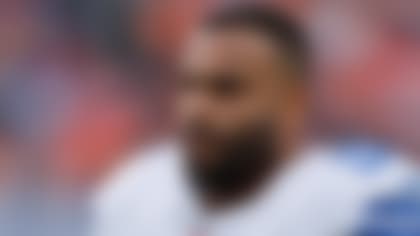Exploiting matchups is key in fantasy and can help us unearth sleepers, value plays and also alert us to when we should fade or lower expectations for more establish studs. There are a number of statistics and data-based tools to helps us decipher which matchups to exploit and which to avoid, and one of which is the NFL's Next Gen Stats package -- not just the fancy speed numbers you see on television.
Here we'll look where cornerbacks and wide receivers line up, which defenses are particularly susceptible to which player packages and so much more in order to find value with our fantasy players. As the season goes along we'll have even more data to use and a better understanding of the Next Gen Stats. Here are the top matchups that could bring value in Week 8.
Randall Cobb vs. Falcons secondary
Rather quietly, Randall Cobb has re-emerged as a top option in the Green Bay offense. In Weeks 1 through 3 Cobb totaled 132 yards on 12 catches and never found the end zone. Since the Packers Week 4 bye, Cobb has 27 catches for 256 yards and two touchdowns. While Jordy Nelson and the vertical passing game diminish as the season wears on in Green Bay, Cobb and the underneath attack are experiencing an upswing.
The key for Cobb's resurgence has been his usage. Not only are his total targets up from 18 in the first three games to 37 in the past three, but his deployment in key areas has also taken an upswing for racking up more production. It was clear in the early going of the season that what the Packers were doing on offense was not working. Putting Cobb in more favorable spots was clearly a point of emphasis in their attempt to turn the operation around.
Since the Week 4 bye Cobb's percentage of snaps out of the slot are up from 62.3 percent to 79.7 percent. His use in running routes over the middle of the field is also trending up with 55.6 percent of his targets of his targets coming between the numbers in Weeks 1-3 and 67.6 percent in Weeks 5-7. The Packers are also using Cobb more in the scoring area. Jordy Nelson had a 50 percent market share of the red-zone targets in the first three games of the season, but that distribution has completely flipped on its head. Since Week 5, Cobb trails only Ty Montgomery in market share of the team's red-zone targets with 23 percent. He's also hauled in two targets inside the 10-yard line, both of which he took for scores. Last Thursday night Cobb also saw an additional two targets in the end zone, both of which came over the middle of the field with each nearly resulting in touchdowns.
The emphasis in changing Cobb's deployment has all been about getting him into space and creating easier throws for Aaron Rodgers, rather than asking the slot receiver to consistently win against isolated man coverage. A big part of that has not only been the use out of the slot and in the middle of the field, but also dialing back how far they target him down the field. Rodgers' intended air yards when targeting Cobb is down from 10.2 in the first three weeks to 8.5 the last three games. All this has helped Cobb get more separation on his targets and into space to make plays:
Cobb's re-imagined position in this offense will be a key cog for the Packers when they travel to Atlanta to take on the Falcons. Atlanta allows the second-most passing yards in the NFL with 2,157 through seven games. Much of their production comes from quarterbacks picking them apart in the middle of the field and short areas. The Falcons allow the second-most yards to tight ends and the most yards to receiving running backs in the NFL. With shutdown corner Desmond Trufant almost exclusively sticking outside, the Falcons funnel passing offensive production into the middle of the field and their coverage linebackers and slot corners haven't been up to the task in assistance.
Philip Rivers made that weakness glaringly apparent in Week 7 with 33 of his 44 attempts coming inside the numbers. Antonio Gates had eight of his 10 targets come from the middle of the field as well and lined up in the slot on 45 percent of his pass plays, hauling in four catches for 35 yards. With the Packers lacking a true threat at tight end, it will be Randall Cobb and Ty Montgomery that are left to exploit the heart of the Falcons defense. Everything looks lined up for Cobb to continue to capitalize on his newly reconfigured role in Green Bay's offense.
Kelvin Benjamin vs. Patrick Peterson
After starting the season with 199 yards and three touchdowns in the first two games of the season, Kelvin Benjamin has gone quiet. In his next four contests, Benjamin has yet to clear 90 yards receiving and found the end zone just once. The volume is there, as he's garnered 30 targets over the last three weeks.
While much of the issue of Benjamin not accessing his fantasy ceiling of late stems from the overall ineffectiveness of the Panthers offense this year compared to last, some fault does come back to who he is as a player. He's never been the most technically sound player and is still prone to mistakes. Benjamin averages 2.0 yards of separation from the nearest defender at target this season, which ranks 81st in the NFL and is below the league average of 2.7 yards. Of course, his size still makes him a threat even when he doesn't have a ton of separation. So far this season Benjamin has a 50 percent catch rate (16 targets) when he has less than a yard of separation.
Benjamin doesn't exactly get an easier test this week as he's set to take on the Cardinals and their All-Pro cornerback, Patrick Peterson. Arizona's top secondary defender has been his usual stellar self this season, allowing just a 62.6 passer rating in coverage on the year. Quarterbacks only complete 56.3 percent of their passes when they target Peterson. As usual, the Cardinals move him around the formation a good amount this year.
Patrick Peterson's 2016 alignment:
Left corner: 57.6 percent
Right corner: 32.2 percent
Slot corner: 9.2 percent
Safety: one percent
The last time he played a clear No. 1 receiver Peterson tracked Brandon Marshall around the field in Week 6, covering him on over 60 percent of Marshall's passing plays. The Jets likely knew this was coming, as they moved Marshall into the slot, where Peterson and other top shadow corners rarely travel, on a season-high 37 percent of his overall snaps.
The Panthers have tried to use Benjamin out of the slot more this season, where he's garnered 23 percent of his targets. Three of his four touchdowns have come when he's lined up in the slot as well, including his Week 1 score against Denver:
The Panthers will need to use this sort of game plan to have Benjamin avoid Peterson's coverage. Otherwise, it's hard to consider him a favorite to best one of the top cover corners in the NFL on a down-in, down-out basis. Unless he just completely breaks through in this matchup, volume will have to keep Benjamin afloat in this game. Luckily, that's exactly what happened in Week 7 against the Saints:
Julian Edelman vs. the Bills
Julian Edelman averaged just 49 yards per game through the first four weeks of the regular season. The hope was that Tom Brady's return from suspension would help buoy Edelman's production, but that hasn't been the case. Edelman actually averages just 41.7 yards per game over the last three weeks, despite hauling in 18 total catches.
Contrary to what one would assume, Brady's return has actually had a net negative on Edelman's usage. His targets per game are up from 6.75 to nine in Weeks 5 through 7, but the targets have actually become less valuable. In the first four weeks of the season, the Patriots backup quarterbacks' passes when targeting Edelman averaged 8.45 yards in the air. That figure cratered to 6.1 air yards per target with Brady under center. Edelman's 4.1 air yards per completion from Brady over the last three weeks is the lowest among any team's top receiver.
This constant use on the shortest of routes make it nearly impossible for Edelman to hit big plays and his role in the red zone has been compromised with the current makeup of the team. In the three games with Brady under center and Rob Gronkowski fully healthy Edelman owns an 11.1 percent share of the team's red-zone opportunities (targets and running back carries). That's tied with James White for third on the team. In the nine games, he played in 2015 Edelman owned an 18.4 percent share of the red-zone opportunities, which trailed only LeGarrette Blount's 21 rushes inside the 20-yard line.
With his complete lack of downfield or even intermediate usage, Edelman will need more red-zone work in order to pay back his value in fantasy lineups. When projecting change in a player's current production trajectory, you always have to ask yourself: why would this change? It's hard to tell yourself a story where he suddenly starts garnering more red-zone chances with the twin tight end towers a fixture and one of the top short-yardage backs in the league holding down the fort.
Tyrell Williams vs. Denver cornerbacks
Rather quietly, Tyrell Williams is on track to be one of the breakout stars of the season. Williams is on pace for just over 1,200 yards and 70 receptions, despite just a 107 target pace. He runs into a tough matchup this week against the Broncos in Denver, who limited him to just 28 yards in their last meeting.
Both Denver cornerbacks have been as good as usual this season. Slot corner Chris Harris has been targeted 40 times this season and allowed just 168 yards and two touchdowns. Aqib Talib is playing at a Pro Bowl level, allowing a 34.4 passer rating on 41 targets.
That was outside of the norm for the Chargers' use of Williams, but the results had to be tantalizing. On the season Williams has racked up 36 percent of his 47 targets from the slot while lining up there on just 74 snaps. Harris is a good corner, no question, but he'd likely have more success against him than Aqib Talib on the outside. So far on the season Williams has been an inconsistent separator on a per-target basis, averaging 2.5 yards of separation on his targets, ranking 56th among receivers with 20-plus targets.
Jeremy Maclin vs. Vontae Davis
So far this season Jeremy Maclin hasn't made much noise at all. The top Chiefs receiver has yet to clear 80 yards receiving and he hasn't scored since Week 1. He's gone deathly quiet in a run-first offense that suddenly has intriguing depth options like Chris Conley and Tyreek Hill.
It's hard to pinpoint exactly what's gone wrong for Maclin from a statistical standpoint. He's still on pace for 120 targets, and only 23 percent of the receivers who saw 120 or more targets from 2011 to 2015 finished outside the top-24 fantasy receivers. Maclin is also being targeted just over a yard farther down the field this season, with Alex Smith averaging 12.2 intended air yards when targeting Maclin. The efficiency also remains, with Smith averaging 10.3 air yards on his completed passes to Maclin. He's also right around the league average (2.7 yards) in separation from the nearest defender on his targets with a 2.6-yard average.
Smith is even taking more chances downfield on big plays this season, as he did in Week 7:
Week 8 could sneakily hold an opportunity for Maclin to get going again. Vontae Davis is the only truly credible threat in the Colts secondary, but he's only shadowed a top receiver in one game. In Week 6 Davis tracked Hopkins on 30 pass plays and gave up just 31 yards on four catches to the Texans' Pro Bowl wideout. Outside of that game, Davis has been locked in at right cornerback where he's played 92.8 percent of his snaps. He's allowed just 160 yards receiving in those five games.
With the way Jeremy Maclin is producing this season, it's fair to wonder whether the Colts will dictate that Davis needs to shadow the Chiefs top receiver. Should Davis stick at right corner, he'll rarely see Maclin across the way from him. So far this season Maclin takes 39 percent of his snaps from the slot and 33 percent of his snaps from right wide receiver.
Everyone is ready to give up on Maclin, but if he gets to run the majority of his routes against the inferior members of the Indianapolis secondary, he could be in line for a big game. The Colts offense has plenty of mismatches on the Chiefs defense, including T.Y. Hilton lining up away from Marcus Peters, and the Chiefs offense should move the ball with Spencer Ware against the Colts stop unit. If this game turns into a sneaky high-scoring affair, Maclin could finally break through after an icy cold stretch.
Devontae Booker vs. the Chargers
News broke Thursday morning that C.J. Anderson would go on IR and likely miss the rest of the season. With the veteran back set to miss an extended stretch, rookie Devontae Booker inherits the opportunity of a lifetime. The Broncos registered 190 rushing attempts through their first seven games, which is good for the seventh-most in the NFL. With no credible threat behind him, Booker should see the lion's share of those opportunities.
Even before this injury, Booker was already starting to eat into Anderson's workload. Booker's snaps were on a general upward trending heading into Week 7, and that culminated in the rookie taking more snaps than Anderson on Monday Night Football.
Perhaps we can see a reason for the beginning of that change when looking at the Next Gen Stats. Lowest distance traveled per rushing yard gained is a metric that shows a relation to downhill running backs that aren't wasting much motion in charging through the heart of defenses. We've also seen some relationship between players having a higher yards per carry when their distance traveled/yard gained number goes down, and vice versa. Outside of Week 1, Booker was either keeping pace or besting Anderson in lowest distance traveled per rush yards gained:
Week - Booker - Anderson
Week 1 - 6.6 - 3.7
Week 2 - 3.5 - 4.4
Week 3 - 6.5 - 5.3
Week 4 - 4.3 - 5.6
Week 5 - 4.3 - 4.3
Week 6 - 2.6 - 4.5
Week 7 - 3.3 - 3.0
What this might show is that Booker was finding holes and getting to them faster than Anderson, which is why the Broncos may have felt the change of pace was necessary. Booker has a chance to be a slight upgrade over Anderson, who was already playing well.
The Chargers rank a middling 14th in running back distance traveled/yard gained, allowing a 4.2 average. Though, they are improving as a front seven with the full integration of rookie Joey Bosa. Booker has 20-touch upside in this spot, so even if the defense is getting better, he's a top-10 running back play on the week.
Russell Wilson and Jimmy Graham vs. Saints
Russell Wilson has yet to re-capture the momentum he carried through the end of the 2015 season. The Seahawks starter has cleared 300 passing yards just once and failed to throw a touchdown in three of his six games, only tossing multiple touchdowns in one contest.
One conclusion to make is that the injuries Wilson is reportedly playing through (knee and pectoral) are limiting his ability to play his style of football. In 2015 Wilson threw 19.1 percent of his passes outside of the pocket. So far this season, he's attempted just 11.2 percent of his passes outside of the pocket. While he's been effective on those limited attempts with an 88.2 passer rating, he just doesn't appear healthy enough to execute the roll outs and improvisational plays with much regularity.
Perhaps even more concerning is Wilson's inability to get the ball out with as much effectiveness when he's had more time to improvise this year. In 2015, Wilson completed 53.2 percent of his passes when he had more than 2.5 seconds to throw with a 106.5 passer rating and an 18-to-four touchdown-to-interception ratio. Under the same criteria, this season Wilson has completed just 45.6 percent of his passes and his passer rating has dipped to 83.5.
Being able to extend plays and cut up defenses is key to Wilson's game, especially with the offensive line in the shape it's in this season. It seems that the Next Gen Stats hint that the improvisational aspect of Wilson's play has been compromised for the time being. However, we also see from his passing charts in his two most effective games (Weeks 4 and 6) that he can still deliver as a traditional passer in plus matchups:
In Week 6, Wilson showed that he can carve up a defense with effective short throws over the middle of the field. In Week 4, before their bye, Wilson took more deep shots with effectiveness against the Jets. Let's not get confused -- Wilson can still make a defense pay with his arm even if his health isn't all the way ready to cooperate yet.
The key to this game will be the use of former Saints tight end Jimmy Graham. The Pro Bowl tight end looks not only fully healthy after a patellar tendon tear, but also completely ingrained in the Seahawks offense after a slow 2015 start. Some of Graham's route charts show that they're using him in a variety of ways:
Graham is catching passes on crossers over the middle, passes to the sidelines and even down the seams. Unlike last season, the Seahawks look like they're ready to let Graham be the player he truly is, and not just play traditional tight end. So far this season Graham has accumulated 50 percent of his yards when lined up in the slot and 14 percent out wide, compared to just 36 percent when lined up at tight end. The notoriously generous Saints defense is unlikely to have an answer for the tight end they traded away over a year ago. Playing in the Superdome, where the Saints score more points and bring teams out of their own shell, look for the Seahawks sleeping giant of an offense to wake up.
Matt Harmon is an associate fantasy writer/editor for NFL.com, and the creator of #ReceptionPerception, who you can follow on Twitter _@MattHarmonBYB_ or like on Facebook.




